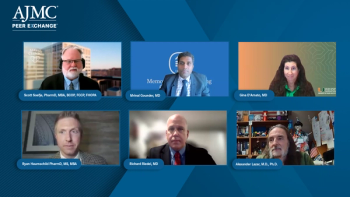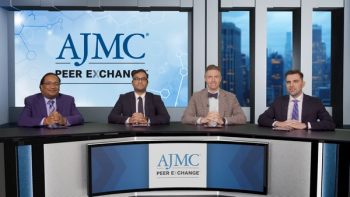
Enhancing NSCLC Neoadjuvant Therapy
A panel deliberates post-neoadjuvant strategies and data requirements for optimizing immune checkpoint inhibitors in NSCLC neoadjuvant therapy.
Episodes in this series

David Carbone, MD, PhD: I think there’s a big controversy in the field right now, and there’s some thought about doing in a melanoma trial in lung, formally comparing adjuvant to neoadjuvant. I don’t know what you all think about that, but to me, the most compelling question is what to do after neoadjuvant and surgery. The PTHrP [parathyroid hormone-related protein] patients do well, but they don’t do perfectly. Is there any benefit to giving additional adjuvant monitoring ctDNA, those kinds of things, and then the non-PTHrP, should we be intensifying therapy somehow? And I think those are really questions that need to be addressed in the future. Comments from the medical oncologists about what to do?
Martin Dietrich, MD, PhD: I don’t know, but I would love to hear your thoughts. But my approach, and if I were offered a trial comparing neoadjuvant versus adjuvant, we have 2 trials in the adjuvant setting that really weren’t as convincing as the 5 trials we have in the neoadjuvant perioperative setting. It’s a trial I wouldn’t want to be enrolling into. I think the data is of theoretical value in the clinic. I think we have moved from adjuvant into a neoadjuvant.
Patrick Forde, MBBCh: Yeah, I think I agree. I think we’ve taken a little bit of a lead from our breast cancer colleagues where they did some of these studies looking at the duration of postoperative therapy. I don’t think they’ve ever actually completely eliminated the postoperative course after neoadjuvant. We were kind of lucky in lung cancer in that we had a study of just neoadjuvant, whereas it was probably a bit of a fluke more than anything else. But I do think one of the key questions is going to be what you do postoperatively, because there may be additional benefit, but there’s also additional toxicity in multiple ways, costs, physical toxicity to patients, loss of their freedom from coming to the clinic. I think there are multiple ways there where we have to weigh up benefit and risk. I think some of those studies are planned and being conducted looking at that postoperative course. I think that’s going to be a key question.
David Carbone, MD, PhD: And then, of course, some studies use 3 cycles before, some use 4, we don’t have the data on what’s the optimal.
Patrick Forde, MBBCh: But we do have the PCR question. The PCR, if anything, was a little bit higher with the 3 cycles. Now it’s different patients.
David Carbone, MD, PhD: Not a randomized trial you would be in favor of.
Patrick Forde, MBBCh: Three versus 4 is a bit too much.
David Carbone, MD, PhD: Dr Forde, what do you think is needed to better support the utilization of immunotherapy as neoadjuvant therapy. We talked a little bit about possible trials, postoperative sense.
Patrick Forde, MBBCh: I’d probably separate it into 2 things. I think practical things, which we’ve spoken about, some of those, kind of operationalizing the factor of changing a whole paradigm from just giving postoperative therapy to neoadjuvant, and that involves surgeons, medical oncologists, radiation, everyone, patients, and making it clear what neoadjuvant therapy is to patients. In terms of the data, we still have a maximum 3-year event-free survival now. It’s looking very promising in CheckMate 816. It looks pretty promising in the 2 other phase 3 trials. There was a phase 2 trial from Spain, as well, which looked very promising from Dr Provencio and colleagues. I think we have building data, and none of them are significant for overall survival as yet, but 2 of them are quite close. CheckMate 816 and KEYNOTE-671. They’re very close to a significant overall survival benefit. I think that will emerge, and I’m pretty convinced at least 1 of these trials will show a significant benefit, probably with less toxicity than some of the adjuvant trials.
I think the other questions we need to address are really for those patients who are getting less benefit, those patients who are not having PCRs, can we add new agents? So, when we get a drug in advanced disease, which looks amazing, we don’t wait 5 or 10 years to move it into early-stage disease. I think that post-op setting is going to be key. How do we design trials to examine, say, adding a novel agent to PD-1 or PD-L1 or targeted therapies even, you know, in some of the other, BRAF, for example, where you can get both benefit for immunotherapy and targeted therapy.
David Carbone, MD, PhD: You could argue for putting novel agents in the neoadjuvant side of the equation too, because there you have a rapid readout for efficacy, you have pre and post tissue samples for biomarker studies, and if it’s been proven to be safe and not cause problems, I think it’d be very interesting to investigate certain combinations in the neoadjuvant space, as well.
Transcript has been AI generated and reviewed by an AJMC editor.
Newsletter
Stay ahead of policy, cost, and value—subscribe to AJMC for expert insights at the intersection of clinical care and health economics.








































